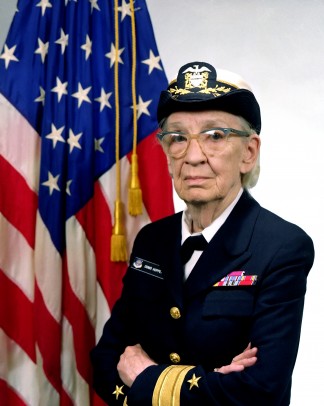Four life hacks from computer pioneer Grace Hopper

Grace Hopper “had this spirit that students could learn from,” says Women in Science and Engineering director Veronica Arreola. Photo: U.S. Navy
Computer programmers know how to hack, but Grace Hopper knew much more — she was a life hacker.
Local filmmaker Melissa Pierce presented 10 “life hacks” by Grace Hopper at the Women’s Leadership and Resource Center March 11 at an event sponsored by the Women in Science and Engineering Program.
Pierce is unveiling the colorful life of computer scientist and U.S. Navy rear admiral Hopper in a new documentary, “Born with Curiosity: The Grace Hopper Story.” It’s set to release in December 2016 – Dec. 9 would have been Hopper’s 110th birthday.
“I never thought I would make a film about her,” said Pierce, executive director of Chicago Women Developers. “But when there are 12 films about Steve Jobs, another in the making, there needs to be one for Grace.”
Hopper is known for coining the term “debugging” after finding a moth in a computer.
“Grace made it famous because she found the first actual bug,” Pierce said. “But it’s not what we should know of her.”
Tackle big things
Hopper didn’t learn how to program until she was 37 years old.
She was a mathematics professor before she joined the Navy on her third try during World War II. Hopper was denied the first two times for being underweight and holding a job too important to national security.
Upon acceptance, Hopper was assigned to work on the Harvard Mark I: a 10,000-pound computer used in World War II. It was long before then that Hopper learned how to understand machines.
Break stuff to understand it
As a young girl, Hopper took apart seven alarm clocks to learn how they worked and how to fix them. “It illustrates the point that she wasn’t afraid to break things apart,” Pierce said.
Credit – give it and take it
Hopper never forgot to credit the female team that worked with her. “Grace was incredible about the women she worked with,” Pierce said. “She knew that you should hold onto really good people and make concessions for them.”
Hopper is associated with the creation of the COBOL language, one of the first high-level programming languages, Pierce said.
“But she came up with the idea of a compiler,” she said. “A program that translates machine language into human language, which is what COBOL is based off. You can thank Grace for being able to have an app on your iPhone, and the same app on your friend’s Android.”
Persistence finds a way
Hopper was a genius, but she was also persistent. “People are framed as geniuses just because they persist,” said Veronica Arreola, director of the Women in Science and Engineering Program and the organizer of the event. “From what I know of Grace, she had this spirit that students could learn from.
“Even rocket scientists have to persist.”
Pierce is raising funds for “Born with Curiosity” on the crowdsourcing site IndieGoGo. For more information, visit the film’s website.

